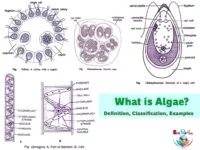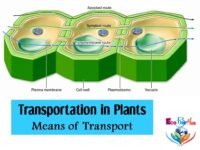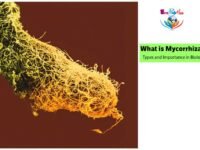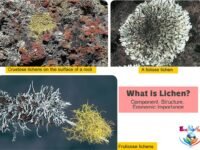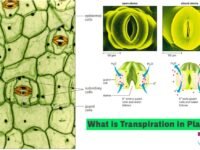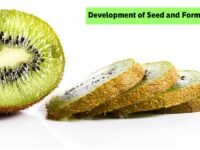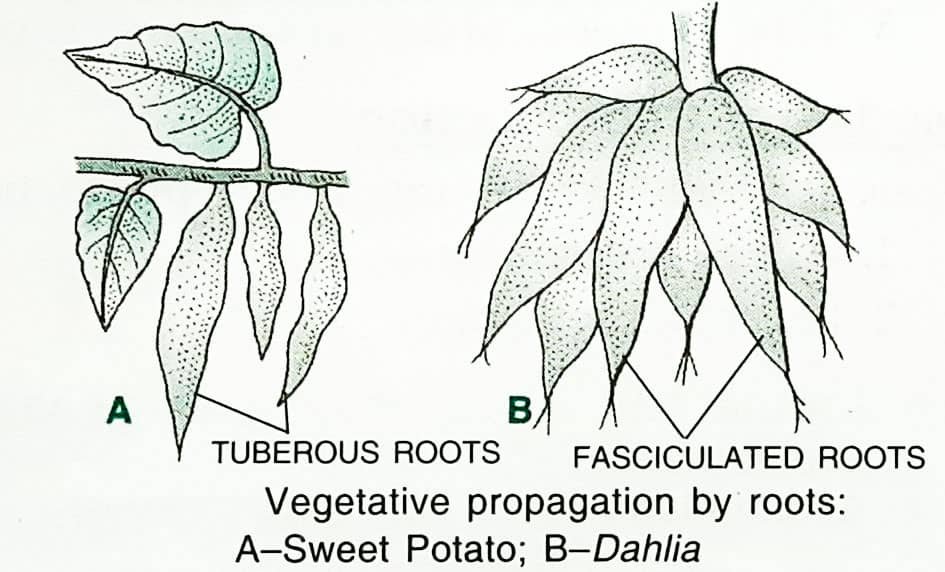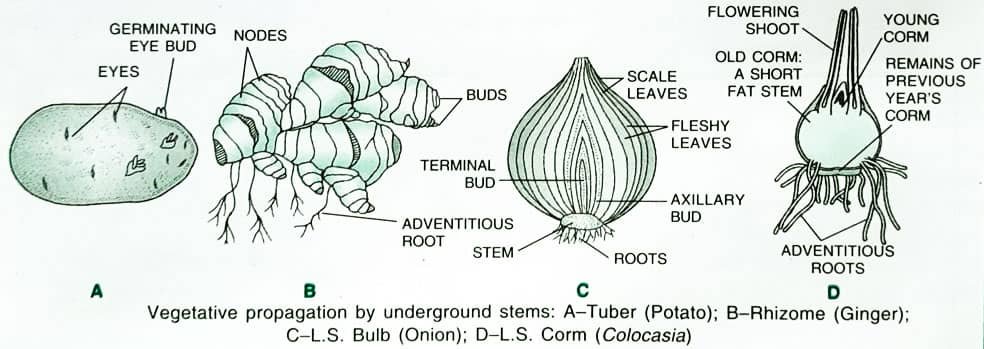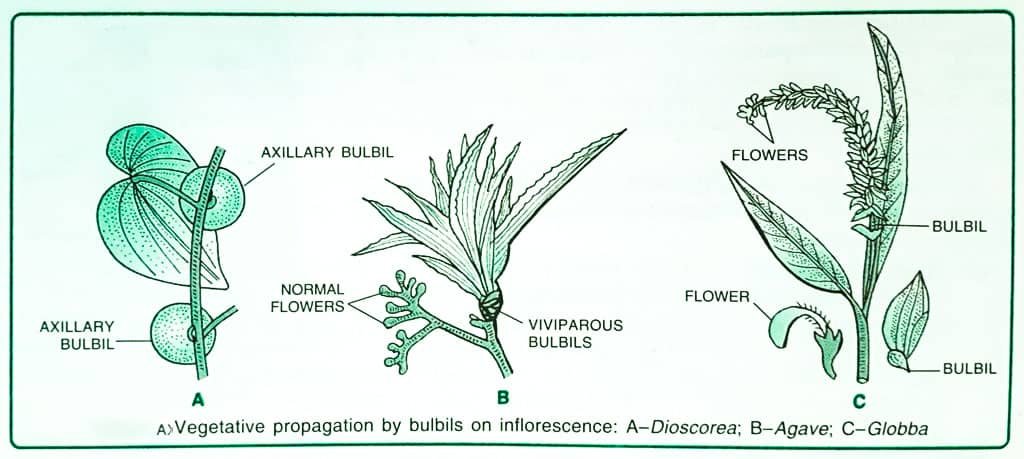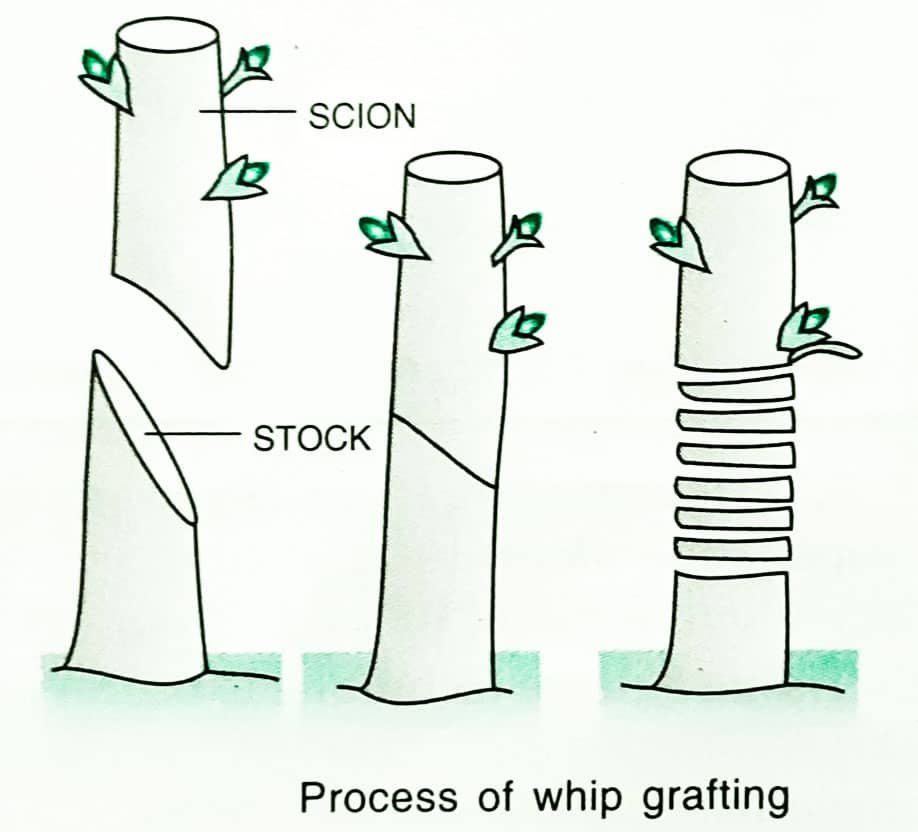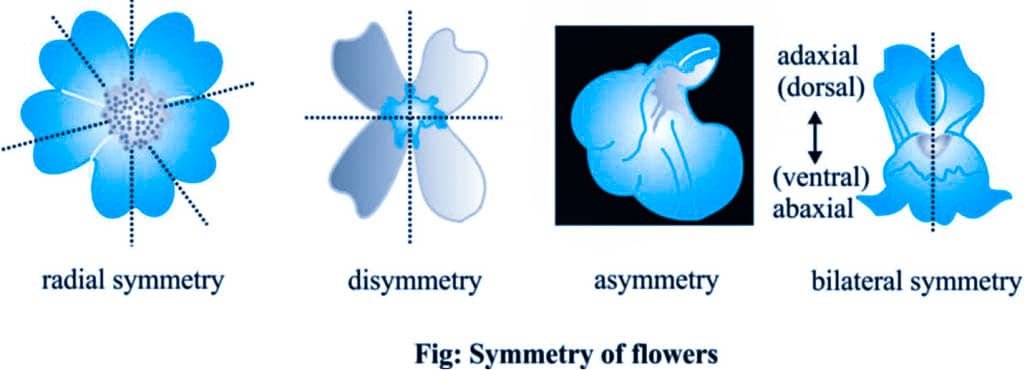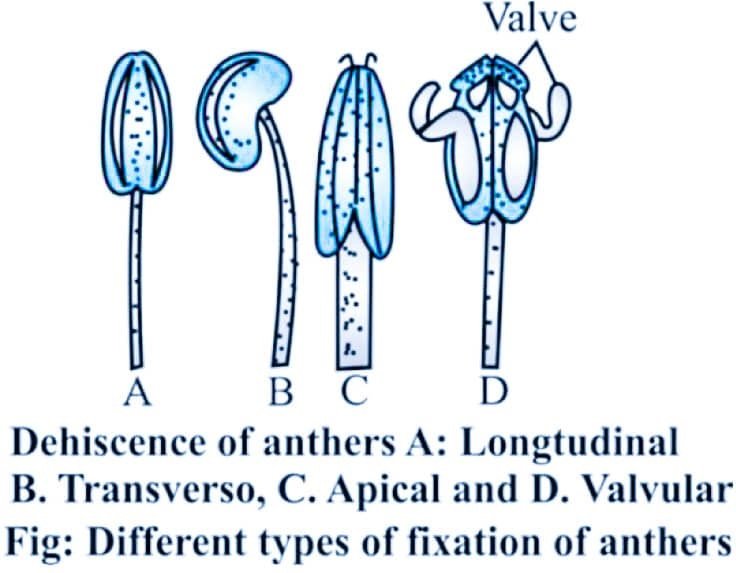In this tutorial, we had described reproduction in plants by means of sexual and asexual reproduction.
TABLE OF CONTENTS
WHAT IS A REPRODUCTION?
Reproduction is a biological process in which an organism gives rise to young ones (are called offspring). The young ones grow, mature, and repeat the process.
Characteristic Features of Reproduction
All modes of reproduction have some basic features:
1. Synthesis of RNA, proteins, and other biochemicals.
2. Replication of DNA, i.e., formation of carbon copies of DNA.
3. Cell division and growth of cells.
4. Formation of reproductive units.
5. Development of new individuals from reproductive units.
Purpose of Reproduction
1. Continuity of Species: Reproduction maintains the continuity of the species.
2. Population Organisation: It maintains a population of young, adults, and aged individuals of a species.
3. Replacement: It replaces individuals dying due to aging.
4. Variations: It introduces variations in the organism. Useful variations help in adaptations and evolution.
5. Life: The existence of life on the earth is possible only due to reproduction. Basically, there are two modes of reproduction:
Modes of Reproduction
Basically, there are two modes of reproduction:
1. Asexual reproduction
2. Sexual reproduction
Asexual reproduction is favoured by the aquatic environment because it is more stable than terrestrial one. Amphimictic is the term used for the plants reproducing sexually.
TABLE: Differences between Sexual and Asexual Reproduction
Sl. No.
Sexual Reproduction
Asexual Reproduction
01.
It involves the fusion of the male and female gametes. That means gametes are formed and fertilisation takes place.
It does not involves the fusion of the male and female gametes. That means gametes are not formed and fertilisation does not takes place.
02.
It is biparental, which means it requires two different individuals.
It is uniparental, which means it requires only one individual.
03.
It involves both mitosis and meiosis.
It involves mitosis.
04.
Daughter organisms share the genes and characters of both parents, so they are not identical to their parents and show variations from each other and also from their parents.
Daughter organisms are genetically identical to the parent and hence called clones.
05.
It occurs almost in all animals. Both sexual and asexual modes of reproduction are found in plants.
It occurs in invertebrates and lower plants (such as algae and fungi).
06.
It is a fast process i.e., multiplication occurs rapidly.
It is a slower process.
07.
Since it does not introduce variations in offspring, it does not contribute to evolution.
Since it introduces differences in offspring, it leads to the evolution of species.
ASEXUAL REPRODUCTION
Asexual Reproduction Definition
Production of offspring by a single parent without the formation and fusion of haploid gametes is called asexual reproduction. The offspring produced are identical morphologically and genetically and are called clones. The term ‘ramets‘ is used for the members of a clone.
Occurrence
Asexual reproduction is common in single-celled organisms such as Monerans, Protistans, simple plants, and simple animals. It is absent in higher invertebrates and all vertebrates. It is of common occurrence in the majority of plants.
Basic Features of Asexual Reproduction
1. It is uniparental as only one individual is involved.
2. It does not involve the formation and fusion of gametes (Agamogony or agametogenesis).
3. It does not require the formation of special reproductive organs.
4. All the cell divisions are mitotic. So, asexual reproduction is also called somatogenic reproduction.
5. Daughter individuals produced are morphologically similar and genetically identical to each other and to the parent.
6. It is a rapid means of reproduction.
7. Haploid-diploid alternation of generations does not occur.
8. There is no wastage or extra expenditure of body resources in the formation of a large number of gametes as in sexual reproduction.
Vegetative Propagation in Angiosperms
Angiosperms do not produce asexual bodies like spores for asexual reproduction. They multiply by vegetative propagation. It is the formation of new plants from vegetative parts of the parent plant like root, stem, leaf, or bud.
The term ‘vegetative propagation‘ is applied only to plants. It is found in several aquatic and terrestrial species of angiosperms. The units of vegetative propagation such as runner, rhizome, tuber, sucker, bulb, etc., give rise to new plants. These structures are called vegetative propagules.
■ Methods of Natural Vegetative Propagation
1. Vegetative Propagation by Roots
In plants like Sweet Potato, Dahlia, Asparagus, Tapioca, etc., the tuberous roots have adventitious buds. When these bud-bearing tuberous roots are put into the soil, they develop into new plants. The roots of Guava, Murraya, Dalbergia sissoo, and Albizia lebbek have buds. These put out shoots and produce new plants.
2. Vegetative Propagation by Stem
(a) Vegetative Propagation by Sub-aerial Stems: Sub-aerial stems are runner, sucker, stolon, and offset. In Lawn Grass (Cynodon), Doob Grass, and Hydrocotyle, the sub-aerial stem grows along the surface of the soil and produces roots downwards and shoots upwards from the nodes. Such stems are called runners. The dry grasses bearing buds, on getting water, develop into new plants.
In Pudina (Mint), Chrysanthemum, and Pineapple, the sub-aerial stems are known as suckers, and which grow obliquely upwards to give rise to a new plant. Sub-aerial stems produce new plants in Water Hyacinth (Eichhornia) through offset and in Strawberry and Blackberry through stolon.
Water hyacinth is one of the fastest growing weeds found in standing water of ponds and lakes. It floats in water with the help of a spongy stem and inflated petioles of leaves. It grows by means of offsets which bear leaves and roots in clusters at the nodes. Once it starts growing, its eradication becomes very difficult. It was introduced in India for its broad and attractive leaves and showy flowers. The luxurious growth of water hyacinth makes water oxygen-deficient and fishes start dying for want of oxygen.
(b) Vegetative Propagation by Underground Stems: The underground stems of plants like Potato, Sugarcane, Banana, Ginger, Turmeric, Onion, etc. multiply by vegetative propagation as follows:
(i) The eyes (buds) present in the tuber of Potato give rise to aerial shoots.
(ii) Buds on the rhizomes of Banana, Ginger, and Turmeric give rise to aerial shoots which develop into new plants under favourable conditions.
(iii) The bulbs of Onion, Tulip, and Daffodil are modified shoots. Each bulb has one or more terminal buds that grow into new shoots and produce a new bulb at the end of the growing season.
(iv) The corn of Crocus, Colocasia, and Gladiolus has swollen bases of the stem which have buds for vegetative propagation.
(c) Aerial Stems (Aerial Shoots): Aerial modified stems of Opuntia and some other plants develop new plants when stem segments fall on the ground.
3. Vegetative Propagation by Leaf Buds
The fleshy leaves of certain plants like Bryophyllum and Begonia bear adventitious buds inside the notches present along the margin of leaves. When these leaves fall on moist soil, each bud germinates into an independent plant.
4. Vegetative Propagation by Flower Buds (Bulbils)
In Dioscorea, Globba, and Agave, special structures called bulbils occur on the inflorescence. These are modifications of flowers. Bulbils grow into new plants when shed from the mother plant.
■ Methods of Artificial Vegetative Propagation
Horticulturists use some special methods of vegetative propagation like cutting, layering, grafting, or gootee for the rapid multiplication of desired varieties of ornamental plants and fruit trees.
1. Cuttings
In this method, stems are cut obliquely into 20 cm to 30 cm long pieces with a minimum of two nodes and one internode. Rooting hormone IBA or NAA is applied to one end of each cutting and is planted into moist soil. The cuttings develop adventitious roots and shoots from nodes and grow into new plants.
Stem cuttings are very common in plants like Rose, Coleus, Grapes, Sugarcane, China Rose, Lemon, Drumstick, and Bougainvillea.
Root cuttings are commonly used in plants like Tamarind, Raspberry, and Blackberry. Roots of healthy plants are cut obliquely into 10 cm long pieces and placed in moist soil in a horizontal position. Roots and shoots develop to form new plants from these cuttings.
 2. Grafting
2. Grafting
Grafting is carried out commonly in plants like Mango, Guava, Apple, Citrus, Pear, etc. In this method, the root portion is taken from one plant and is called the stock, while the stem portion is taken from another plant and is called the scion.
The stock is always a plant that is resistant to diseases and has a deep root system for absorbing water and minerals. The scion is from a plant that yields better quality of fruits. Grafting can be whip grafting, cleft grafting, and crown grafting.
(a) Whip Grafting or Tongue Grafting: In this type of grafting, stock and scion are of the same diameter and are obliquely cut and placed end-to-end in such a way that the cambium of the two are in intimate contact. The stem of the stock is cut 20–30 cm above the ground. Leaves and buds are removed from this part. Both the stock and scion are bound firmly with the help of a tough thread or tape and are covered with grafting wax to avoid any infection.
(b) Cleft Grafting or Wedge Grafting: In cleft grafting, a V-shaped notch is made in the stock in which a twig of the scion with the wedge-shaped cut is inserted and then tied together.
(c) Crown Grafting: More than one scions are grafted to one stock by wedge grafting.
3. Bud Grafting (Budding)
In this method, a single bud along with a certain portion of the living tissue of the scion is taken and inserted in the incision made in the stock. Budding is usually done during the rainy season so that buds may not dry up and die. Bud grafting is generally done in Rose plants.
4. Layering
Layering is the method of producing roots on a stem while it is still attached to the parent plant. It is done in two ways:
(a) Mound Layering: The lower branch is bent to the ground and covered with moist soil. The apical portion of the branch is left exposed to air. Adventitious roots develop from the buried part. These branches are then cut from the parent plant and planted as new plants. Mound layering is practised in plants like Lemon, Jasmine, Strawberry, Raspberry, Grapevine, etc.
(b) Aerial Layering or Gootee: This method is used in plants like Orange, Guava, Lemon, Litchi, etc., having thick branches which cannot be bent. In such plants, about an inch of bark around the stem is removed and it is covered with moist grass wrapped with a polythene sheet. When adventitious roots appear, the stem is cut below the level of the roots and planted.
5. Micropropagation (Propagation by Plant Tissue Culture)
This is a technique of propagating plants by culturing cells or tissues in culture. When vegetative propagation is not possible in a plant, its bud, shoot apex, or some other part is used for micropropagation.
Tissue culture technique is useful in the commercial propagation of Carnation, Gladiolus, Orchids, Chrysanthemum, and other ornamental plants. This method is also useful for the quick multiplication of plants.
Advantages of Vegetative Propagation
1. It is a cheaper, rapid and convenient method of growing plants. For example, certain lilies take 4 to 7 years from germination to flowering. When grown vegetatively, they bear flowers within 1 to 2 years.
2. Plants like Banana, Fig, Grape, Pineapple, Orange, Rose, Chrysanthemum, Jasmine, Tulip, etc., do not form viable seeds. These are grown only by vegetative propagation.
3. The plants with no seeds or with long seed dormancy multiply by this method only.
4. Desirable characters of fruits and flowers can be maintained in plants grown by vegetative propagation.
5. Disease-free plants can be obtained by vegetative propagation.
6. Effects of environmental variations or of chemicals can be studied on plants when grown vegetatively.
7. Grafting helps in combining good traits from two varieties in a single plant.
8. Plants grown by vegetative propagation have the exact qualities of the parent plant.
9. There is no need to wait for the arrival of suitable weather for seed germination.
10. Good qualities of a species or variety can be maintained.
11. Transgenic plants which may be sterile can be made to multiply.
Disadvantages of Vegetative Propagation
1. It does not produce new varieties.
2. Absence of dispersal leads to overcrowding of plants causing a shortage of space, food, and light.
3. Plants lose vigour when grown repeatedly.
4. Plants so produced are genetically alike, hence they are susceptible to the same diseases.
5. Undesirable characters persist in the species generation after generation.
SEXUAL REPRODUCTION
What is Sexual Reproduction
Sexual reproduction is the process of development of new organisms through the formation and fusion of gametes. It involves four processes:
(i) formation of gametes (haploid cells),
(ii) fusion of gametes to form zygote (diploid),
(iii) repeated mitotic divisions of zygote to form embryo and
(iv) growth of embryo into new individual.
Sexual reproduction in plants was first described by Rudolph Jacob Camerarius. It involves formation and fusion of haploid male and female gametes. The gametes are formed either in the same individual or in different individuals of the opposite sex. These gametes fuse to form the diploid zygote which develops into a new organism. Most of the higher animals reproduce almost entirely by sexual method. Because of the fusion of male and female gametes, sexual reproduction results in offspring that are not identical to the parents or to each other.
He was a German botanist demonstrated sexuality in plants. He identified male and female reproductive organs of plants and described the importance of pollen in fertilisation.
Basic Features of Sexual Reproduction
1. Sexual reproduction is termed biparental.
2. It involves the formation and fusion of haploid male and female gametes.
3. It involves meiosis during gamete formation and mitosis during development of offspring from the zygote.
4. Offspring are neither genetically identical to the parents nor to each other.
Sexual Reproduction in Plants
Sexually there are two types of flowering plants: monocarpic and polycarpic.
1. Monocarpic Plants
These plants produce flowers only once in their life. After flowering, they produce fruits and die. All annuals (e.g., Marigold, Wheat, Rice) and biennial plants (e.g., Radish, Carrot) are monocarpic. A few perennial plants like certain species of Bamboo and Neelakuranji are also monocarpic.
Bamboo (Bambusa tulda) flower only once in its lifetime. This plant dies after it sets seeds. This plant usually flowers after 50-100 years, produces a large number of fruits and dies. Neelakuranji (Strobilanthus kunthiana) flowers once in 12 years. The last time it flowered in September-October, 2006. Its mass flowering transformed large tracts of hilly areas in Kerala, Karnataka and Tamil Nadu (Nilgiri) into widespread blue stretches.
2. Polycarpic Plants
These are perennial plants that flower repeatedly at intervals every year (e.g., Apple, Orange, Mango, Jackfruit, Grapevine, etc.). A few perennial plants bear flowers throughout the year, e.g., China Rose.
TABLE: Differences between Monocarpic and Polycarpic Plants
Sl. No.
Monocarpic Plants
Polycarpic Plants
01.
These plants flower only once.
These plants flower repeatedly at regular intervals.
02.
These plants die after flowering.
These plants do not die after flowering.
03.
These plants are usually annual or biennial. A few are perennial.
These plants are perennial.
04.
Examples: Rice, Wheat, Radish, Carrot, Bamboo and Neelakuranji.
Examples: Apple, Mango, Grapevine and Jackfruit
Flower – The Organ of Sexual Reproduction
■ Flower Definition
– The organs which are specialized to perform sexual reproduction in angiosperms are flowers. Flowers are modified
condensed reproductive shoots, comprising male and female reproductive parts along with accessory floral parts.
– It bears floral leaves and gives rise to seeds and fruits. The study of flowers is called anthology.
– Like a branch, it may develop in the axil of small leaf-like structure called a bract.
– Pedicel is the stalk of the flower.
– Flowers with stalks are pedicellate flowers and without stalks are sessile flowers. In the case of a solitary flower, its stalk is termed as peduncle.
– The tip of the pedicel is called the thalamus or torus or receptacle. Thalamus is formed by the condensation of internodes of the floral axis.
– Floral members are arranged in a spiral or cyclic manner on the thalamus.
There are several evidences to support that flower is a modified shoot. These are: ● Flowers may develop in the axils of bracts like the axillary shoots. ● A floral bud like a vegetative bud is either terminal or axillary in position. ● The arrangement of sepals and petals with respect to each other (i.e., aestivation) is similar to that of the foliage leaves. ● The thalamus represents the axis of the floral whorls with undeveloped or suppressed internodes between them. However, in some flowers, the thalamus becomes elongated showing distinct nodes and internodes, e.g., in Gynandropsis, Capparis, etc. . ● Arrangement of sepals, petals, stamens, and pistil, etc., on the thalamus is the same as that of the leaves on the stem or the branch, i.e., alternate, opposite or whorled. ● Anatomy of the pedicel and thalamus is similar to that of the stem while the vascular supply to different floral organs resembles the vascular supply for ordinary leaves. ● In some plants, flowers are modified into bulbils or fleshy buds that take part in vegetative reproduction, e.g., onion, Agave. ● The floral organs of Nymphaea (water lily) show all stages between a sepal and petal and between a petal and stamen. ● The sepals are similar in morphology to leaves in rose. ● Passion flower (Passiflora) and Cleome gynandra have internodes in between various organs.
■ Structure of a Typical Flower
Flowers are organs of sexual reproduction. Morphologically, a flower is a modified shoot whose internodes are condensed and leaves form four whorls. The whorls of floral appendages successive order are:
1. Calyx: Formed of green sepals.
2. Corolla: Formed of coloured or white petals.
3. Androecium: The male reproductive whorl formed of stamens (microsporophylls).
4. Gynoecium: The female reproductive whorl formed of carpels (megasporophylls).
– Of the four whorls, the calyx and corolla are not directly associated with sexual reproduction rather they serve secondary functions like protection of flower and attraction of insects for pollination. They are termed nonessential or accessory whorls.
– Androecium and gynoecium are directly involved in sexual reproduction and are, therefore, called essential or reproductive whorls. The androecium consists of a number of stamens which represent male reproductive whorl. The gynoecium represents the female reproductive whorl and is formed of carpels.
TABLE: Different Whorls of Flower and their Nature
Floral Whorls
Nature
Position
Components
Functions
01. Calyx
Nonessential
Outermost
Sepals
For the protection of the flower before it opens (in bud condition).
02. Corolla
Nonessential
Inner to calyx
Petals
Brightly coloured and scented and usually in order to attract insects to the flower for pollination.
03. Androecium
Essential
Between corolla and gynoecium
Stamens
This is the male reproductive part of the flower where pollen grains are produced.
04. Gynoecium
Essential
Innermost
Pistil or Carpel
This is the female reproductive part of the flower where the female gametes (eggs) are produced.
– In some flowers calyx and corolla are undifferentiated and cannot be distinguished, They constitute the perianth.
– A flower having all the four types of floral organs is known as complete. The absence of any one or more of the floral parts makes the flower incomplete.
– A flower having both the essential organs is described as perfect, bisexual, hermaphrodite, or intersexual.
If a flower having only one of the two essential floral organs is called imperfect or unisexual. Unisexual flowers may be either staminate (male) or pistillate (female).
When both the essential organs are absent, the flower is called neuter.
– If male and female flowers develop on the same plant, the plant is described as monoecious, e.g., maize, castor, cucurbits.
If male and female flowers are borne on separate plants, they are termed dioecious, e.g., date palm, mulberry, Coccinia grandis.
In trioecious plants male, female and bisexual flowers are present on separate plants, e.g., Silene.
In andromonoecious plants, male and bisexual flowers are present on the same plant, e.g., Veratrum.
In gynomonoecious plants, female and bisexual flowers are present on the same plant, e.g., Asteraceae plants with heterogamous head inflorescence.
– Some plant flowers do not possess sepals and petals. Such flowers are called achlamydeous or naked.
When both calyx and corolla are present, flowers are termed as dichlamydeous.
In heterochlamydeous flowers, the two non-essential whorls possess different colours, e.g., Hibiscus.
In the homochlamydeous flower, the two nonessential whorls possess the same colour, e.g., Artabotrys, the majority of the monocots.
– Some plants possess more than two types of flowers. They are called polygamous. For example, mango (Mangifera indica), Polygonum, and cashew nut (Anacardium occidentale) possess three types of flowers perfect (inter-sexual), staminate and female or neuter.
– Number of Floral Parts
Occurrence of the same number of floral parts in different floral whorls of a flower is called isomery. Depending upon the similar basic number of parts, a flower is described as:
⇒ Bimerous, e.g., Papaver, mustard, etc., (floral parts in the multiple of 2)
⇒ Trimerous, e.g., Asphodelus, most monocots (floral parts in the multiple of 3).
⇒ Tetramerous, e.g., Cruciferae (floral parts in the multiple of 4).
⇒ Pentamerous, e.g., Malvaceae, Solanaceae (floral parts in the multiple of 5)
⇒ Hexamerous, e.g., Argemone (floral parts in the multiple of 6).
A flower is referred to as heteromerous if it has a different number of parts in each whorl. For example, Petunia has 5 sepals, 5 petals, 5 stamens but two carpels.
– Arrangement of floral organs
● Floral organs are borne on the thalamus either in spirals (acyclic or spiral, e.g., Magnolia, Nymphaea), whorls (cyclic, e.g., Petunia), or with some organs in spirals and other organs in whorls (spirocyclic or hemicyclic, e.g., Ranunculus).
●When the floral phyllotaxy is whorled, the number of whorls are often mentioned, like, tetracyclic (e.g., Petunia), pentacyclic, hexacyclic, etc.
– Symmetry of flowers
The symmetry of flowers is classified into three types:
⇒ Actinomorphic / Radial / Polysymmetric: A cyclic flower that can be divided into two equal vertical halves or mirror images by any vertical plane (antero-posterior or median, lateral, diagonal) is said to be actinomorphic or Radial or Polysymmetric. The actinomorphic flower has, therefore, radial symmetry, e.g., mustard, Datura, chili, Tribulus, Hibiscus.
⇒ Zygomorphic / Bilateral: A flower, which can be divided into two equal vertical halves by one plane only, is termed as zygomorphic. It is of two types – medianly zygomorphic (e.g., Salvia, larkspur, pea, bean, gulmohar, Cassia) and laterally zygomorphic (e.g., Fumaria). A zygomorphic flower has bilateral symmetry.
⇒ Asymmetric: A flower that cannot be divided into two equal parts by vertical plane is known as acyclic or asymmetric, e.g., Opuntia, Canna.
Table: Differences between actinomorphic and zygomorphic flower
Sl. No.
Actinomorphic flower
Zygomorphic flower
01.
It has radial symmetry.
It possesses bilateral symmetry.
02.
Two equal halves are formed by any vertical division passing through the centre.
Two equal halves are produced only by one vertical division.
03
It is regular.
Zygomorphic flower is often irregular.
– The axis or part of the stem on which the flower is borne is known as the mother axis. The part of the flower towards the mother axis is the posterior part and the one opposite to it is the anterior part.
■ Functions of a Flower
1. A flower is a modified shoot meant to perform the function of sexual reproduction. The fertile leaves become microsporophylls (stamens) and megasporophylls (carpels). These bear anthers and ovules respectively.
2. Flowers are shaped variously to assist in pollination, the prerequisite for reproduction.
3. The ovary gets transformed into fruit and ovules into seeds after fertilisation.
4. Some floral parts like calyx and various modifications in ovaries help the dispersal of fruits and seeds.
Bracts
– Bracts (hypsophyll) is a small leaf-like structure on the peduncle that bears a flower in its axil. The floral buds are usually protected by the bracts. Flower with a bract is termed as bracteate and the flower without a bract is known as ebracteate.
– Bracteoles are small scale-like structures present on the pedicel. The flowers may be bracteolate or ebracteolate.
– Bracts shows many variations with regard to size, shape, colour, etc.
– Leaf like, expanded green bract is called the foliaceous bract, e.g., Adathoda, Grossandra.
– A large modified bract which encloses spadix inflorescence totally or partially is called the spathe. It may be leathery or woody, e.g., Alocasia, Cocos, Musa, Typhonium.
– Brightly coloured petal like bract is known as petaloid bract, e.g., Bougainvillea, Euphorbia.
– One of two whorls of green bracts that protect young inflorescence is called involucre, e.g., Coriandrum.
– Whorl of bracteoles present below the calyx or outside the calyx constitute epicalyx, e.g., Hibiscus rosa sinensis.
– Reduced, membranous, scale-like bracts are called the scaly bracts. They are seen in head inflorescence, e.g., Florets in Tridax, Helianthus, etc.
– The bracts found on the rachilla of spikelets are called glumes. They may be sterile glumes or fertile glumes (lemma), e.g., Oryza sativa.
Sepals / Calyx
– They constitute the lower accessory whorl or outermost series of mostly green flattened or foliaceous floral organs which are mainly meant for protecting other floral parts in the bud condition.
– When sepals are coloured other than green, they are called petaloid.
– Sepals are described as:
● Polysepalous: Sepals are free, e.g., tomato, mustard, water lily.
● Gamosepalous: Sepals are united, e.g., Datura, brinjal, chili.
– Depending upon the union, the gamosepalous calyx can be toothed (free parts very small), fid (divisions reaching upto half), or partite (divisions more than half). The sepals which are fused only at their bases are termed as connate.
– Calyx can be differentiated on the basis of their duration as caducous, deciduous, and persistent.
● In caducous type, the calyx falls off just after opening the bud, e.g., Argemone mexicana, Papaver, etc.
● In deciduous type, sepals fall off along with petals just after fertilisation, e.g., mustard.
● In persistent type, sepals remain attached with the ripe fruit, e.g., Pisum, Ocimum, solanaceae.
The persistent calyx is of two types:
● Accrescent calyx is the persistent calyx growing in size along with fruit e.g., Physalis.
● Marcascent calyx is the persistent calyx which shows no further growth after fertilisation and assumes a dried up form before being shed, e.g., guava, tomato, brinjal.
– Calyculus is a structure resembling calyx, composed of bracts and bractioles.
– Epicalyx (Hypocalyx) is an extra series of green sepal-like floral organs that lie on the outside of calyx. Epicalyx occurs in some members of Rosaceae (e.g., strawberry) and most of Malvaceae (shoeflower, Althaea). It provides protection to the other floral organs like the calyx.
– Shapes of calyx
The various shapes of the calyx are:
⇒ Campanulate (bell-like e.g., Petunia).
⇒ Capulate (cup-like e.g., Gossypium).
⇒ Urceolate (urn-shaped, e.g., Silene).
⇒ Infundibuliform (funnel-shaped e.g., Atropa).
⇒ Globose (inflated like a globe e.g., Verbena).
⇒ Bilabiate (2-lipped e.g., Salvia).
⇒ Spurred (one or more sepals drawn out into a beak or spur e.g., larkspur, garden nasturtium).
⇒ Hooded (a sepal enlarged to form a hood, e.g., Aconitum).
⇒ Spinous (modified into spines, e.g., Trapa).
⇒ Pappus (modified into hairy processes, e.g., Sonchus)
⇒ Saccate (pouched, e.g., mustard).
⇒ Reflexed (bend backwardly or downwardly, e.g., Cassia).
⇒ Gland dotted (e.g., Citrus).
– Functions of the calyx
● The main function of calyx is the protection of the flower in the bud condition.
● When the sepals are green, the calyx carries on photosynthesis in foliage leaves.
● When the calyx is coloured and showy, it serves the purpose of attraction and thus helps in pollination.
● The modified pappus hairs are persistent in the fruits and help in their dispersal by the wind.
Petals / Corolla
– The inner nonessential attractive whorl, proceeding towards the centre is called the corolla.
Corolla are brightly coloured and attract insects for pollination and protect the inner essential whorls from injury.
– When a petal looks like a sepal it is called sepaloid petal, e.g., Anona, Polyalthia.
Table: Differences between sepaloid and petaloid
Sl. No.
Sepaloid
Petaloid
01.
It is a term used for sepal-like floral organ.
It is a term used for petal-like floral organ.
02.
It is green or greenish.
It is coloured other than green.
03.
Sepaloid is commonly a petal.
Petaloid is commonly a sepal.
– In a petal, the lower part is usually narrow like the stalk of a leaf and is termed claw. The expanded portion of the petal is called the limb.
– Types of corolla
● Corolla may be polypetalous (= choripetalous, petals free) or gamopetalous (= sympetalous, petals fused).
● Polypetalous corolla can be of the following types:
⇒ Cruciform: When four free clawed petals are arranged in the form of a cross, the corolla is said to be cruciform. It occurs in family brassicaceae (= cruciferae), e.g., mustard, candytuft.
⇒ Caryophyllaceous: Corolla consists of five petals with distinct limbs and claws. The claw and the limb of each petal remain more or less right angle to each other, e.g., Dianthus.
⇒ Rosaceous: Five or more sessile or shortly clawed petals bent horizontally like a saucer, e.g., rose (Rosa indica)
⇒ Papilionaceous (or Butterfly shaped): Five unequal or irregular petals are arranged like a butterfly. The posterior large bilobed petal called standard or vexillum, overlaps the two smaller lateral petals named wings or alae. The latter overlap the two anterior petals, which are fused lightly by the upper anterior margins to form a boat shaped structure called keel or carina, e.g., pea, bean etc.
● Gamopetalous corolla can be of the following types:
⇒ Campanulate: Bell-shaped corolla, e.g., Campanula and Cucurbita.
⇒ Urceolate: Urn-shaped, e.g., Bryophyllum.
⇒ Salver-shaped (hypocrateriform): Tubular with spreading lobes, e.g., Clerodendron.
⇒ Infundibuliform: Funnel shaped, e.g., Petunia and Ipomoea.
⇒ Tubular: Tube like a fused corolla, e.g., disc floret of sunflower.
⇒ Rotate: With a short tube having limbs placed transversely like the spokes of a wheel, e.g., Solanum nigrum.
⇒ Bilabiate: Two lipped corolla, characteristic of family lamiaceae, e.g., Ocimum. The two lips may be open (called bilabiate ringent), e.g., Salvia; or lips closed (called bilabiate personate), e.g., Antirrhinum.
⇒ Spur: One or more petals are drawn out like a beak or tubular projection, e.g., Delphinium.
⇒ Ligulate: It is a narrow tube below and flattened above like a strap, e.g., ray florets of sunflower.
– The mode of arrangement of the sepals or petals with respect to one another in the floral bud is termed as aestivation. – In open aestivation, margins of the adjacent petals are sufficiently apart from each other. – In valvate aestivation, sepals or petals or tepals just touch without any overlapping, e.g., Brassica. ⇒ Induplicate valvate: Margins of each part folded inwards, e.g., Ipomoea. ⇒ Reduplicate valvate: Margins of each part projecting outward. – In twisted or contorted type, one margin of each petal overlaps the margin of an adjacent petal and the other margin being overlapped by the margin of another adjacent petal, e.g., china rose. – Imbricate is the aestivation of five parts, where one is exterior, one is interior and the rest three are having one margin exterior and other interior (1 exterior, 1 interior, 3 exterior-interior, i.e., 1, 1,3). It is of two types : ⇒ Descending imbricate or Vexillary: Characteristic of corolla of pea (papilionaceae) where posterior petal is outermost. ⇒ Ascending imbricate: Characteristic of corolla of family caesalpiniaceae (Cassia), where posterior petal is innermost. – Quincuncial is aestivation of 5 parts, where two are exterior, two interior and the fifth is having one margin exterior and the other interior. – Convolute type is a modified form of contorted aestivation and applied when the entire petals are involved in twisting, e.g., Phlox.
– When there is no distinction of sepals and petals, the non-essential floral organs are collectively called perianth.
– Unit of perianth or individual member of perianth is known as tepal, e.g., Asphodelus, onion, lily.
– When the members of the perianth are free the perianth is termed as polyphyllous, e.g., Polygonum, Asparagus, etc.
– When the members of the perianth are united the perianth is termed as gamophyllous, e.g., Polyanthus.
– When the perianth is bright like petals it is called petaloid perianth as in glory lily, water hyacinth etc.
– If the perianth is sepal-like it is called sepaloid perianth as in Acalypha indica, Phyllanthus niruri.
– In grasses the perianth is scale-like and is called lodicule.
Stamens / Androecium
– Stamens are the male reproductive organs of a flower. The stamens collectively form the male whorl or androecium. They are also called microsporophylls. Androecium forms the third whorl of the flower.
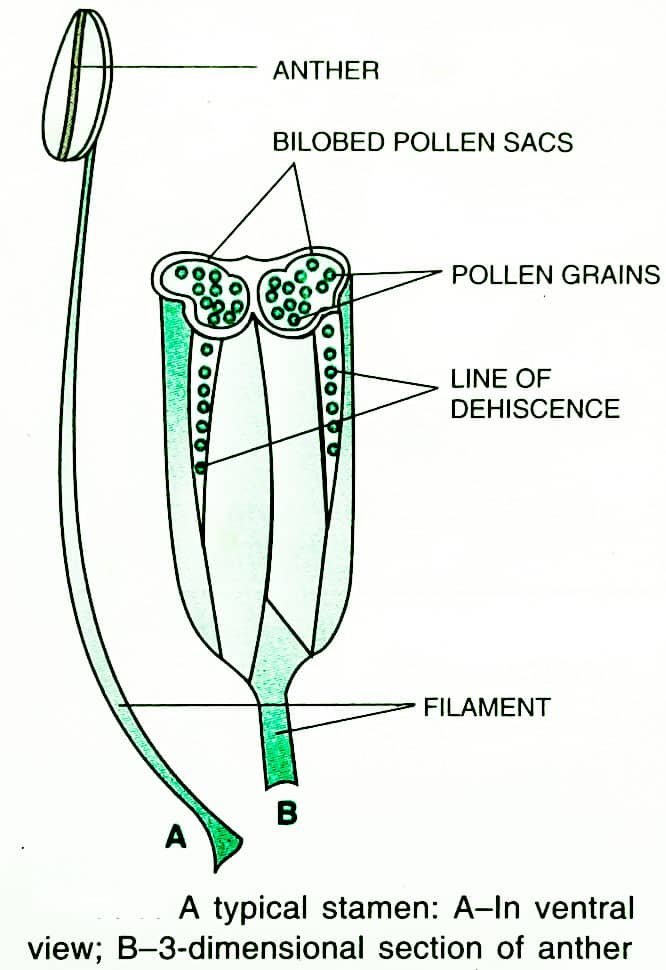 The number, length, and arrangement of stamens vary in flowers of different species. Each stamen has the following three parts:
The number, length, and arrangement of stamens vary in flowers of different species. Each stamen has the following three parts:
1. Filament: It is the stalk-like part of a stamen that supports anther terminally and is attached to the thalamus by its basal end.
2. Anther: It is the swollen bilobed structure at the terminal end of a filament.
– In the majority of angiosperms, anthers are two-lobed or dithecous (i.e., having 2 theca). Two anther lobes or theca united by a slender connective. Each theca (anther lobe) consists of two pollen sacs called locules. which are demarcated by a longitudinal groove on the ventral surface. This denotes the line of dehiscence of anther lobes to liberate pollen grains formed in the pollen sacs. A dithecous anther, therefore, has four pollen sacs and is called tetrasporangiate, Thus a dithecous anther is always tetralocular.
– In plants of Malvaceae (Hibiscus) and Euphorbiaceae (Euphorbia), the anthers are monothecous (bilocular or bisporangiate). Each pollen sac or locule contains a microsporangium. Pollen grains or microspores are produced in the microsporangium.
3. Connective: Each anther has two lobes which are attached at the back by a sterile band called connective.
In some plants, one or more stamens are nonfunctional and without anther, as in roses. Such nonfunctional stamens are called staminodes.
– Spurred stamens occur in Viola. Sterile and undeveloped stamens are called staminodes. Stamens are sessile in Aristolochia.
– In Annona, Tridax, etc., the connective extends beyond the anthers and forms “hood” over them. Such anthers are called hooded anthers. In Calotropis and Nerium staminal corona is present which are appendages of stamens.
– Stamens shorter than the flower are termed as inserted. When stamens protrude out of the flower, they are known as exserted. They may be borne directly on the thalamus or fused with petals (= epipetalous, e.g., Solanum, Petunia) or tepals (= epiphyllous or epitepalous, e.g., Asphodelus.
– Stamens may be alternipetalous (alternate with petals), antipetalous (opposite the petals), alterniphyllous (alternating with tepals) or antiphyllous (opposite the tepals), diplostemonous (in two whorls, outer alternipetalous and inner antipetalous, e.g. Cassia), obdiplostemonous (in two whorls, outer antipetalous and inner alternipetalous, e.g., Pink), isostemonous (similar stamens) and heterostemonous (stamens differ in size, shape or mode of dehiscence, e.g., Cassia).
– If a number of stamens are present in a flower, they may be free or united.
– Fusion with a dissimilar organ is called adhesion while fusion with a similar organ is known as cohesion.
– The free stamens are called polyandrous. They may be equal or unequal in length. The two common types of unequal stamens are tetradynamous (four long and two short, e.g., mustard) and didynamous (two long and two short, e.g., Ocimum)
■ Cohesion of Stamens
Cohesion of stamens is of the following types:
⇒ Adhesion: Stamens are united by their filaments and anthers remain free.
⇒ Monoadelphous: Stamens united by their filaments forming one group, as in China rose (Hibiscus rosa sinensis), Abutilon, Althaea. This condition is a characteristic feature of malvaceae.
⇒ Diadelphous: Here also stamens are united by their filaments forming two groups, either (5 + 5) or (9 + 1) e.g., Tephrosia, Pisum sativum.
⇒ Polyadelphous: This indicates more groups of stamens united by their filaments only, e.g., silk cotton (Bombax).
⇒ Syngenesious: Stamens are united by their anthers only, filaments remaining free. This condition is a characteristic feature of compositae (asteraceae), e.g., Sunflower, marigold.
⇒ Synandrous: Stamens united by both filaments and anthers form a compact structure. This condition is a characteristic feature of Cucurbita maxima.
Table: Differences between monoadelphous and syngenesious stamens
Sl. No.
Monoadelphous stamens
Syngenesious stamens
01.
Stamens are fused by their filaments only.
Stamens are fused by their anthers only.
02.
A staminal tube is formed around the base of the pistíl. The tube may extend to cover the style.
A tube is formed by fused anthers around the style.
03.
Anthers and upper part of the filaments are free.
Only the filaments are free.
■ Adhesion of Stamens
When the stamens adhere to any of the rest of the three whorls, they may be described as follows:
⇒ Epipetalous: Stamens united with the petals, as in Datura.
⇒ Epiphyllous: Stamens united with the perianth leaves, as in onion (Allium cepa).
⇒ Episepalous: When stamens are united with the sepals, e.g., Quisqualis indica.
⇒ Gynandrous: Stamens are partly or wholly united with the gynaecium, as in maddar (Calotropis).
■ Attachment of the Anther to the Filament
The mode of attachment of the anther to the filament varies greatly in flowers. It is of the following types:
⇒ Basifixed (or Innate): Here the filament is attached to the base of the anther, as in mustard, Datura, radish.
⇒ Adnate: Here the filament is fixed to the anther in such a manner that it runs up the entire length of the anther at its backside, e.g., Magnolia, Ranunculus, Nymphaea.
⇒ Dorsifixed: The filament is fixed to the dorsal side or back of the anther and anther is immovable, e.g., Hibiscus rosa sinensis, Passiflora, Sesbania, Prunus.
⇒ Versatile: The filament is attached to the middle of the connective so that anther lobes can swing on it freely. An example of this type is found in most of the grasses.
■ Types of connectives
– When the connective is very narrow, so that the two anther lobes lie in close proximity as in Adhatoda, Euphorbia sp, it is called discrete.
– When the connective is broad and the two anther lobes are separated as in Tilia sp, it is called divaricate.
– In Salvia, the connective is highly elongated. Its one end bears a fertile anther lobe while the other end has a sterile anther lobe. It is called distractile.
■ Dehiscence of anthers
These are of the following types :
⇒ Longitudinal: lengthwise slits, e.g., Datura, mustard, Ranunculus, Citrus. The longitudinal dehiscence is of three types:
● Laterorse (Lateral): Slits appear on the sides.
● Introrse: Slits are formed towards the inner side or centre of the flower.
● Extrorse: Slits lie towards the outer side of petals.
⇒ Transverse: breadthwise slits, e.g., Malva, Althaea.
⇒ Valvular: anther lobe breaks at places by lifting of surface layers, e.g., berberry, camphor.
⇒ Porous: by pores, e.g., Solanum (tomato), Cassia.
⇒ Irregular: e.g., Najas.
Table: Differences between introrse anthers and extrorse anthers
Sl. No.
Introrse anthers
Extrorse anthers
01.
They dehisce by slits appearing towards the inner side.
Extrorse anthers dehisce by slits formed on the outer side.
02.
Pollen grains are shed towards the side of the pistil.
Pollen grains are shed towards the side of corolla
03.
They are found only in entomophilous flowers.
Found in both anemophilous as well as entomophilous flowers.
04.
Nectar glands, if present, occur between pistil and stamens.
Nectar glands, if present, are found between stamens and petals.
Carpels / Gynaecium
– The gynoecium (or pistil) is in the centre of the flower. It is the fourth whorl. It is the innermost whorl. It bears the female reproductive organ called carpel. The gynaecium is composed of one or more carpels. When there is a single carpel, the pistil is called simple or monocarpellary, as in pea.
– If there are multiple carpels are called megasporophylls.
Depending on the number of carpels gynaecium may be bicarpellary ( E.g. Sunflower, Tridax, etc), tricarpellary, tetracarpellary, pentacarpellary, and polycarpellary (or multicarpellary) having two, three, four, five, and more than five carpels respectively.
– The free occurring unit of gynaecium is called pistil. Pistil is a flask-shaped structure. It has a basal swollen ovary, a stalk-like style, and a terminal receptive part called stigma.
– Types of Ovary
Ovary has one or more chambers or loculi (singular loculus): For example;
⇒ unilocular (e.g., pea)
⇒ bilocular (e.g., mustard)
⇒ trilocular (e.g., Asparagus)
⇒ tetralocular (e.g., Ocimum)
⇒ pentalocular (e.g., China rose)
⇒ multilocular (e.g., Althaea, lady’s finger).
– In the chambers are present oval outgrowths called ovules
– Types of Style
Depending upon its origin, style is of three types:
⇒ Terminal (= apical, arising from top of ovary, e.g., Petunia, castor).
⇒ Lateral (from side of ovary, e.g., mango)
⇒ Gynobasic (from mid-basal part of ovary, e.g. Salvia, Ocimum of family lamiaceae).
Style may be unbranched or branched.
– Stigma or the terminal receptive part of pistil can be linear, fid (divided), lobed, decurrent, striated, capitate, funnel shaped, feathery, hairy, or sticky. In lobed condition, the number of lobes generally corresponds to number of fused carpels.
● Stylopodium: When the base of the style is swollen to form a pad-like structure, it is called stylopodium, e.g., in family umbelliferae or apiaceae (coriander). ● Plumose stigma: Feather-like stigma is called the plumose stigma, e.g., in grasses. ● Resupination: Turning or twisting of ovary or flower through 180°, i.e., upside down is called resupination. It is a feature of most of the orchids.
– Types of Carpel
Carpels may be free, when gynaecium is called apocarpous (e.g., polycarpellary apocarpous in rose, lotus, Ranunculus) or fused when it is known as syncarpous (=compound, like bicarpellary syncarpous in mustard and Petunia, tricarpellary syncarpous in Asphodelus, polycarpellary syncarpous in Althaea.
Fusion may occur in the region of ovaries only (e.g., pink), ovaries and styles (e.g., shoe flower or China rose), or ovaries, styles, and stigmas, e.g, Petunia).
Table: Differences between apocarpous and syncarpous ovary
Sl. No.
Apocarpous ovary
Syncarpous ovary
01.
The ovary belongs to a single free carpel.
The ovary belongs to a single pistil.
02.
The flower has several free ovaries.
There is a single ovary.
03.
It is always unilocular.
It may be unilocular or multilocular.
04.
On maturity, it forms fruitlet aggregate type.
On maturity, it forms of a simple fruit.
– Types of Ovules
Depending upon position of micropyle in relation to chalaza and funiculus, ovules are of 6 types in angiosperms. These are orthotropous, anatropous, hemianatropous, campylotropous, amphitropous and circinotropous.
1. Orthotropous: This is the most primitive type of ovule. Its funicle is straight and the ovule lies straight in the ovary. The funicle, chalaza, and micropyle lie in one vertical line.
Examples: Walnut and Polygonum.
2. Anatropous: This is the most common type of ovule found in angiosperms (i.e., in 82% of angiosperm family). In it, the body of an ovule is inverted and the micropyle lies close to the hilum. The funicle is curved at the apex and fuses with the integuments forming raphe. The micropyle and chalaza lie in one vertical line.
Examples: Gram and Pea
3. Amphitropous: In this type, the ovule lies transversely at the right angle over the stalk of the funicle. The micropyle and chalaza lie in a transverse line instead of the vertical line.
Examples: Citrus, Lemon, etc.
4. Campylotropous: The body of the ovule becomes curved or bent like a horseshoe, so that micropyle, funicle, and chalaza come to lie at one pole and funicle does not fuse with integuments.
Examples: Capparis, Mustard, etc.
5. Hemitropous: The body of the ovule as well as embryo sac are curved so that hilum, chalaza, and micropyle lie in close proximity.
Example: Capsella.
6. Circinotropous: The ovule is straight with a micropyle facing upwards. The funicle is elongated, coiled and it completely encircles the ovule. Initially, the ovule is orthotropous but later on, becomes inverted due to unilateral growth of the funicle.
Example: Opuntia.
Placentation
Placenta is a parenchymatous cushion present inside the ovary where ovules are borne. The arrangements of ovules in the chambers of the ovary is known as placentation.
– Types of Placentation
There are different types of placentation.
01. Marginal Placentation
Ovary is unilocular and the placenta develops along the ventral suture. A true placenta is believed to be absent.
It is found in monocarpellary pistils of leguminosae (e.g., pea, Cassia, Acacia) and other plants (e.g., larkspur).
02. Axile Placentation
Ovary many-chambered and sincarpous. The placenta develops from the central axis, e.g., Petunia (bilocular), Asphodelus (trilocular), tomato (bi or tetralocular), China rose (pentalocular), Althaea and lemon (multilocular).
Table: Differences between marginal and axile placentation
Sl. No.
Marginal placentation
Axile placentation
01.
The ovary is always unilocular.
The ovary is two or more locular.
02.
The ovary is simple or monocarpellary.
The ovary is compound and syncarpous.
03.
Ovules are attached to the wall of the ovary.
Ovules are attached to a central or axile column.
04.
Ovules occur on a single placenta.
The number of placenta depends upon the number of fusing carpels or septa.
03. Central Placentation
Ovary is multicarpellary, syncarpous but one-chambered and placenta develops from the central axis as in Dianthus, Primula, etc.
Table: Differences between axile placentation and free-central placentation
Sl. No.
Axile placentation
Free-Central placentation
01.
Ovary is partitioned into chambers.
There is a single chamber in the ovary.
02.
The ovule bearing column is attached to the wall of the ovary by septa.
Ovule bearing column lies free in the centre of ovary. Septa are absent.
04. Parietal Placentation
Ovary is multicarpellary, syncarpous but one-chambered and the placenta arises from the inner wall of the ovary as in Poppy.
Sometimes the unilocular ovary is found to be divided by the development of a false septum (wall) called as a replum e.g., mustard, Cucurbita, Passiflora, Argemone, and other members of brassicaceae.
Table: Differences between marginal and parietal placentation
Sl. No.
Marginal placentation
Parietal placentation
01.
It occurs in monocarpellary or simple ovary.
Parietal placentation is found in a compound or syncarpous ovary.
02.
There is a single longitudinal placenta bearing ovules attached to the ovary wall.
There are two or more longitudinal placentae bearing ovules attached to the ovary wall.
03.
The ovary is always unilocular.
The ovary can be unilocular or become falsely two or more locular due to ingrowth of placentae or formation of false septa.
05. Basal Placentation
Ovary is monocarpellary with one locule and the placenta develops at the base of the ovary as in family compositae like sunflower (Helianthus annuus), marigold, Ranunculus.
06. Superficial Placentation
Ovary is polycarpellary, syncarpous, and with many locules and the placenta develops all around the inner surface of the partition walls as in Water Lily.
Thalamus
– The thalamus is the suppressed swollen part of the flower which lies at the tip of the pedicel and bears floral organs. In some plants, the thalamus shows distinct nodes and internodes.
– The internode between calyx and corolla is termed anthophore, e.g., Silene; that between corolla and androecium, the androphore, e.g., Passiflora and that between androecium and gynoecium, the gynophore or gynandrophore, e.g., Cleome.
– The shape of the thalamus also varies with the plants. When thalamus is prolonged into gynaecium to form a central axis it is called carpophore, e.g., coriander.
Position of floral leaves on thalamus
– There are three forms of the thalamus as regards the insertion of pistil and androperianth or other floral organs, viz., hypogyny, epigyny, and perigyny.
– When the sepals, petals, and stamens are successively and separately inserted below the ovary in the flowers, the condition is known to be hypogyny and the ovary is said to be superior. Such flowers are called hypogynous as in mustard, China rose (shoe flower), Petunia, Ranunculus, and brinjal.
– When the sepals, petals, and stamens are successively and separately inserted above the ovary in the flower, the condition is described as epigyny. The ovary in this situation is said to be inferior. Such flowers are termed epigynous, e.g., guava, cucumber, apple sunflower.
– When the sepals, petals, and stamens are inserted at the same plane as the ovary, the condition is known as perigyny. Such flowers are called perigynous.
– Perigynous thalamus is of three subtypes:
● Disc shaped, e.g., pea, Cassia.
● Cup shaped, e.g., Prunus (plum, peach)
● Flask shaped, e.g., rose.


